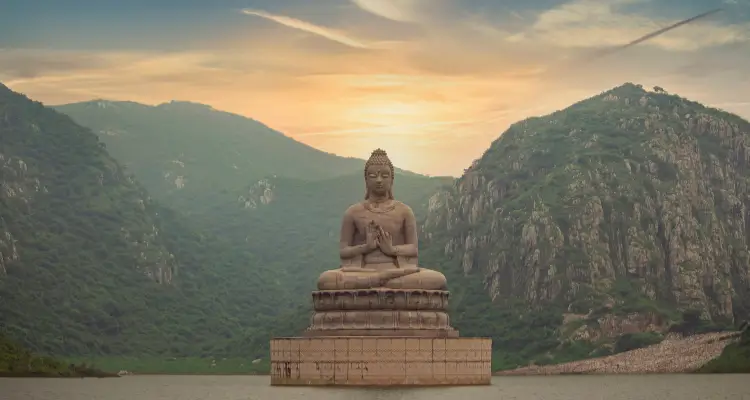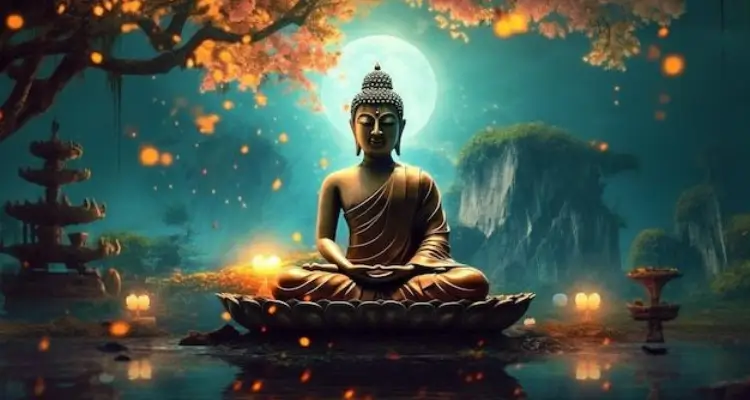Buddhism is a spiritual tradition with more than 2,500 years of history that continues to inspire millions of people around the world. Its teachings, centered on compassion, wisdom, and the pursuit of inner peace, began with a remarkable journey. But what was the event that marked the beginning of this tradition? How did Buddhism, as we know it today, take shape?
To answer these questions, we must first understand the life of Siddhartha Gautama, the historical figure who became the Buddha. Born into a privileged environment, Siddhartha’s path to enlightenment was shaped by his dissatisfaction with worldly luxuries and his deep desire to find the root cause of human suffering. His experiences, struggles, and eventual enlightenment laid the foundation for the teachings that became Buddhism.
In this article, we will explore the key moments that led to the birth of Buddhism. From Siddhartha’s early life as a prince to his journey of renunciation and discovery, each step will be presented in a simple and clear way, making it easy to grasp the essence of this profound spiritual tradition.
Here’s what you can expect to learn:
- Who was Siddhartha Gautama, and what made his life extraordinary?
- The pivotal events that led him to leave behind wealth and luxury.
- How his search for truth gave rise to the Middle Way and the core principles of Buddhism.
By the end of this text, you will have a clear understanding of how Buddhism began and why its message remains relevant today. Let’s dive in!
Who Was Siddhartha Gautama?
Siddhartha Gautama, known as the Buddha, was a historical figure who lived in ancient India around the 6th century BCE. He is the founder of Buddhism, a spiritual tradition that seeks to understand and overcome human suffering. But before becoming the Buddha, he was an ordinary man with an extraordinary origin.
His Origins: The Sheltered Prince
- Siddhartha was born into a noble family as the son of a king in the Shakya clan, in what is now Nepal.
- His birth was surrounded by prophecies: a sage predicted he would either become a great ruler or a spiritual teacher.
- His father, hoping Siddhartha would choose the path of political power, raised him in luxury and shielded him from any exposure to suffering.
Life in the Palace
- Siddhartha grew up surrounded by wealth, comfort, and pleasures.
- He married young and had a son, living what seemed to be an ideal life.
- However, despite all the luxury, he began to feel a profound dissatisfaction and a longing for something beyond material pleasures.
This phase of Siddhartha’s life is crucial to understanding the beginning of his spiritual journey. Despite his privileged upbringing, he realized that wealth could not bring lasting happiness, leading him to seek deeper answers about the nature of life and human suffering.
Life as a Prince
Siddhartha Gautama grew up in an environment of extreme luxury and comfort, completely shielded from the hardships and suffering of the outside world. This isolation, carefully orchestrated by his father, had a profound impact on his initial worldview and was a crucial stage that shaped his spiritual journey.
A Palace of Pleasures
- Siddhartha was raised in three separate palaces, one for each season of the year, ensuring he never experienced discomfort or deprivation.
- He had everything he could wish for: fine clothes, exquisite food, entertainment, and servants at his disposal.
- His father, fearing Siddhartha would abandon his princely life to follow a spiritual path, forbade him from encountering any form of suffering, such as illness, aging, or death.
The Impact of Isolation
- Growing up surrounded only by pleasures, Siddhartha developed a limited view of the world, believing life was solely about joy and abundance.
- This excessive protection also created a sense of emptiness, as he began to realize that, despite all the luxuries, he still felt an inner restlessness.
- This isolation heightened his natural curiosity and planted the seeds of his desire to explore the world beyond the palace walls.
Although life in the palace was filled with comforts, Siddhartha felt that something essential was missing. This realization was the first step toward his quest for deeper answers about the meaning of life and the purpose of human existence.
The Encounter with Suffering
Siddhartha Gautama spent most of his life shielded from any contact with suffering. However, in a series of life-changing encounters, he was confronted with realities that deeply transformed his worldview. These episodes, known as “The Four Sights,” ignited an uncontrollable desire in him to understand suffering and seek answers to life’s purpose.
The Four Sights
- Old Age: During one of his rare outings from the palace, Siddhartha saw an elderly man, bent with age and struggling physically. He was struck by the realization that aging was inevitable for everyone.
- Illness: On another outing, he witnessed a person gravely ill, writhing in pain. This encounter made him question the fragility of the human body and the inevitability of physical suffering.
- Death: On his third sighting, he observed a funeral. For the first time, Siddhartha understood that death was the ultimate fate of all living beings, regardless of wealth or status.
- An Ascetic: Finally, Siddhartha encountered a simple yet serene man who had renounced the material world to pursue a spiritual purpose. This sight deeply impressed him, as it seemed to reveal peace beyond suffering.
Reflections and the Search for Answers
- These visions confronted Siddhartha with the impermanence of life and the inevitable cycle of birth, suffering, and death.
- He realized that despite all his palace’s luxuries, they offered no answers to these fundamental questions.
- Inspired by the ascetic, Siddhartha decided to leave his privileged life behind and seek the truth about human existence, aiming to overcome suffering.
These encounters were the catalyst for Siddhartha’s spiritual journey, marking the beginning of his quest for a path to liberate humanity from suffering.
The Search for Truth
Siddhartha Gautama’s decision to abandon his life as a prince marked a turning point in his spiritual journey. By leaving behind the comforts and luxuries of the palace, he embarked on an unrelenting quest for answers that could explain human suffering and lead to liberation.
The Decision to Abandon His Life as a Prince
- Siddhartha made the difficult choice to leave his family, including his wife and newborn son, to pursue a higher calling.
- During the night, he quietly left the palace, renouncing his title as a prince and the privileges that came with it.
- He exchanged his luxurious garments for the simple robes of an ascetic and began his journey as a seeker of truth.
The Journey in Search of Understanding
- Learning from Spiritual Teachers: Siddhartha initially sought guidance from renowned masters, learning deep meditation techniques and philosophical teachings. However, he realized that these practices, while valuable, did not lead to complete liberation.
- Extreme Ascetic Practices: Determined to find answers, Siddhartha adopted a life of extreme asceticism, depriving himself of food, comfort, and rest. He believed mortifying the body could bring spiritual clarity, but this path left him on the brink of death.
- The Middle Way: After years of failed attempts, Siddhartha concluded that extremes—whether indulgence or self-denial—were not the path to enlightenment. He thus formulated the concept of the Middle Way, a balance between indulgence and discipline.
Siddhartha’s search for truth was marked by courage, determination, and deep reflection. He was willing to sacrifice everything to understand the nature of existence and find a solution to human suffering.
Ascetic Practices
Siddhartha Gautama’s ascetic practices marked an intense chapter in his quest for truth. For years, he subjected himself to severe deprivations, believing that mortifying the body could bring spiritual enlightenment. However, this approach proved insufficient, leading Siddhartha to abandon extreme asceticism.
Extreme Experiences of Deprivation
- Siddhartha joined a group of ascetics who advocated for the total rejection of bodily pleasures and needs.
- He practiced prolonged fasting, reducing his food intake to the bare minimum, and exposed his body to harsh conditions of discomfort.
- These practices left him physically weakened, to the point of nearly losing his life.
Why Siddhartha Abandoned This Approach
- Realization of Ineffectiveness: Despite his extreme efforts, Siddhartha realized that self-imposed suffering did not bring him closer to the spiritual understanding he sought.
- Understanding the Need for Balance: He concluded that punishing the body only distracted the mind from the clarity needed to achieve enlightenment.
- The Middle Way: This experience led Siddhartha to formulate the idea of the Middle Way, which avoids the extremes of indulgence and deprivation, seeking a balance that sustains both body and mind in the spiritual journey.
By abandoning asceticism, Siddhartha showed the courage to reassess his beliefs and adjust his approach, moving one step closer to discovering enlightenment.
Achieving Enlightenment
The moment Siddhartha Gautama achieved enlightenment is one of the most significant events in Buddhist history. After years of seeking, he found the answers he was looking for while meditating deeply under the Bodhi Tree. This transformative experience made him the Buddha, or “the Enlightened One.”
The Moment Under the Bodhi Tree
- Siddhartha decided to sit under the Bodhi Tree, vowing not to rise until he had found the truth.
- During days of intense meditation, he faced temptations and distractions, including illusions created by Mara, the lord of desire and illusion.
- His determination and focus led him to understand the Four Noble Truths and the Eightfold Path, the core principles of Buddhism.
How Siddhartha Became the Buddha
- The Achievement of Enlightenment: By reaching a state of profound understanding, Siddhartha freed himself from the cycle of suffering (samsara) and attained nirvana.
- The Title of Buddha: “Buddha” means “the one who has awakened.” This title reflects his new condition as someone fully aware and free from the illusions of the world.
- Sharing the Wisdom: After his enlightenment, he dedicated the rest of his life to teaching the principles of Buddhism, guiding others on their spiritual journeys.
Under the Bodhi Tree, Siddhartha turned his personal quest into a universal journey, offering the world a path to overcome suffering and achieve inner peace.
The First Teachings
After achieving enlightenment, Siddhartha Gautama, now the Buddha, began spreading his wisdom to help others free themselves from suffering. His first act of teaching was a landmark event in Buddhist history, laying the foundation for a tradition that continues to this day.
The Beginning of Buddha’s Sharing of Wisdom
- Following his enlightenment, Buddha pondered whether the world was ready to understand what he had discovered.
- He decided to share his knowledge with those open to comprehending universal truths.
- Buddha started his teaching journey with a group of former ascetic companions who had previously abandoned him.
The Importance of the First Sermon in Sarnath
- The First Sermon: Delivered at the Deer Park in Sarnath, the sermon was called “The Turning of the Wheel of Dharma.” In it, Buddha explained the Four Noble Truths and the Eightfold Path.
- First Disciples: The five ascetics who heard the sermon became the first Buddhist monks, marking the beginning of the Sangha, the community of practitioners.
- Enduring Significance: This sermon laid the groundwork for Buddhism, serving as a foundation for subsequent teachings and inspiring millions over the centuries.
Through the First Sermon, Buddha transformed his personal experience of enlightenment into an accessible teaching, offering a clear path to overcoming suffering and seeking inner peace.
Formation of the Sangha
After sharing his initial teachings, Buddha recognized the need for a community to preserve and spread the Dharma (teachings). Thus, the Sangha was born—a community of monks and followers that played a vital role in the history of Buddhism.
The Emergence of the Community
- The First Monks: After the First Sermon at Sarnath, the five ascetics who heard Buddha’s teachings converted and became the first monks.
- Rapid Growth: Gradually, men and women from various backgrounds began following Buddha, forming a community dedicated to the practice and transmission of the Dharma.
- Rules of Conduct: To maintain harmony within the Sangha, Buddha established a set of rules and disciplines known as the Vinaya.
How This Helped Consolidate Buddha’s Teachings
- Preservation of the Dharma: The Sangha ensured that Buddha’s teachings were orally transmitted across generations, maintaining their purity and significance.
- Mutual Support: Monks and followers supported each other, creating an environment conducive to study, practice, and meditation.
- Buddhism’s Expansion: The Sangha acted as a missionary force, spreading the teachings throughout India and, later, across the world.
The formation of the Sangha was a pivotal step in ensuring that Buddhism not only survived but thrived, becoming a global spiritual tradition that continues to inspire millions today.
The Expansion of Buddhism
After the formation of the Sangha, Buddhism began spreading beyond the borders of India. This dissemination was marked by historical events, missionary efforts, and the adaptability of Buddha’s teachings to different cultures and contexts.
How Buddhism Spread to Other Regions
- Ashoka, the Great Patron: Emperor Ashoka of ancient India played a significant role in the early expansion of Buddhism. He embraced the religion after a period of deep remorse for his actions as a conqueror.
- Sponsored Buddhist missions to regions such as Sri Lanka, Southeast Asia, and the Hellenistic world.
- Commissioned the construction of stupas and Buddhist monuments across his empire.
- Trade Routes: Overland trade routes, like the Silk Road, and maritime paths connected India to other civilizations, facilitating the transmission of the Dharma to China, Japan, Korea, and other parts of Asia.
- Translation of Sacred Texts: The translation of Buddhist texts into different languages, such as Chinese and Tibetan, shaped regional schools of the Buddhist tradition.
Its Relevance Over the Centuries
- Cultural Adaptation: Buddhism adapted its teachings to local cultures, creating schools and traditions like Zen in Japan, Theravada in Southeast Asia, and Vajrayana in Tibet.
- Global Spirituality: Over time, Buddhism transcended borders, inspiring people of diverse backgrounds and religions with its principles of compassion, wisdom, and non-violence.
- Modern Revival: In the 19th and 20th centuries, Buddhism regained global prominence, especially in the West, through influential figures like the Dalai Lama and Zen masters.
Buddhism has not only endured through the centuries but also thrived, remaining one of the most influential spiritual traditions in the world.
Conclusion
The Legacy of Siddhartha and Buddhism’s Impact
The story of Siddhartha Gautama is a journey of personal transformation that has left a profound and lasting mark on the world. From a prince surrounded by luxury to a seeker of truth, he dedicated his life to understanding suffering and sharing the path to liberation. His legacy lives on not only in the teachings of the Dharma but also in how Buddhism has influenced cultures, philosophies, and millions of lives over the centuries.
Now that you’ve learned about Siddhartha Gautama’s inspiring journey, take a moment to reflect: What part of this story inspires you the most?
- Is it his determination to seek the truth?
- His compassion in sharing the Dharma with the world?
- Or the simplicity and depth of his teachings?
Share your thoughts in the comments and join the exchange of ideas about this rich spiritual tradition. Your perspective could inspire others!

































